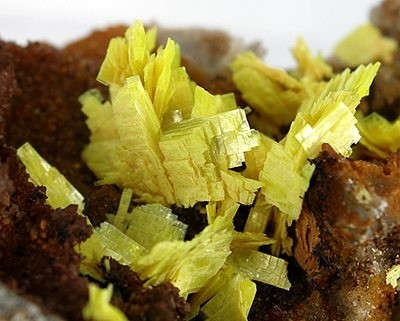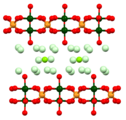Saléeit
| Saléeit | |
|---|---|
| Yellow sale on limonite from the Ranger Mine, Jabiru , Northern Territory, Australia (size 9.6 cm × 6.9 cm × 4.5 cm) | |
| General and classification | |
| other names |
Saléit or Saleit |
| chemical formula | Mg [UO 2 | PO 4 ] 2 · 10-12H 2 O |
|
Mineral class (and possibly department) |
Phosphates , arsenates and vanadates |
|
System no. to Strunz and to Dana |
8.EB.05 ( 8th edition : VII / E.01) 40.02a.11.01 |
| Crystallographic Data | |
| Crystal system | monoclinic |
| Crystal class ; symbol | monoclinic prismatic; 2 / m |
| Space group | P 2 1 / c (No. 14) |
| Lattice parameters |
a = 6.95 Å ; b = 19.95 Å; c = 9.90 Å β = 135.2 ° |
| Formula units | Z = 2 |
| Frequent crystal faces | {001}, {100}, {120}, {012} |
| Physical Properties | |
| Mohs hardness | 2 to 3 |
| Density (g / cm 3 ) | measured: 3.27; calculated: 3.21 |
| Cleavage | completely after {001}, indistinct after {010}, {110} |
| colour | lemon yellow, yellow green to olive green |
| Line color | yellow white |
| transparency | transparent to opaque |
| shine | Diamond luster, wax luster |
| radioactivity | very strong |
| Crystal optics | |
| Refractive indices |
n α = 1.554 to 1.559 n β = 1.570 to 1.582 n γ = 1.571 to 1.585 |
| Birefringence | δ = 0.027 |
| Optical character | biaxial negative |
| Axis angle | 2V = 0 to 61 ° |
| Pleochroism | Visible: X = colorless; Z = light greenish yellow |
| Other properties | |
| Special features | fluorescence |
Saléeit is a mineral from the Autunit group in the mineral class of phosphates , arsenates and vanadates . It crystallizes in the monoclinic crystal system and has the chemical composition Mg [UO 2 | PO 4 ] 2 · 10–12H 2 O and is thus chemically a magnesium - uranyl phosphate.
The pseudotetragonal crystals can be transparent to opaque with a predominantly tabular habit and a dominant base surface perpendicular to the c-axis. The surfaces of the lemon-yellow or yellow-green to olive-green crystals show a diamond to wax-like sheen . The stroke color is yellow-white.
With a Mohs hardness of 2 to 3, Saléeit is on the borderline between soft and medium-hard minerals, which means that it can be scratched either with a fingernail like the reference minerals plaster (hardness 2) or calcite (hardness 3) with a copper coin.
Etymology and history
The mineral was first described in 1932 by Jacques Thoreau and Johannes Franciscus Vaes in silicate rocks from the Shinkolobwe mine in Kasolo in the province of Katanga in the Congo . They named this new mineral after Achille Salée (1883–1932), professor of geology at the Catholic University of Leuven in Belgium .
Type mineral of the mineral is sold at the Catholic University of Leuven in Belgium under catalog no. K1812 kept.
classification
Already in the outdated, but still in use 8th edition of the mineral systematics according to Strunz , the Saléeit belonged to the mineral class of "phosphates, arsenates and vanadates" and there to the department of "uranyl phosphates / arsenates and uranyl vanadates", where it belonged together with Autunit , Fritzscheit , Heinrichit , Kahlerite , Nováčekit , Sabugalit , Torbernit , Trögerit , Uranocircit , Uranospinit and Zeunerit the "Autunit-Gruppe" with the system no. VII / E.01 .
The 9th edition of Strunz's mineral systematics , which has been in effect since 2001 and is used by the International Mineralogical Association (IMA), also classifies the Saléeit in the "Uranylphosphate and Arsenate" department. However, this is further subdivided according to the ratio of uranium oxide complex (UO 2 ) and phosphate or arsenate complex (RO 4 ), so that the mineral can be found in the sub-section "UO 2 : RO 4 = 1: 1" according to its composition , where together with Autunit, Heinrichit, Kahlerite, Kirchheimerit , Metarauchit , Nováčekit-I , Nováčekit-II , Torbernit, Uranocircit I , Uranocircit II , Uranospinit, Xiangjiangit and Zeunerit the "Autunit group" with the system no. 8.EB.05 forms.
The systematics of minerals according to Dana , which is mainly used in the English-speaking world , assigns the Saléeit to the class of "phosphates, arsenates and vanadates", but there in the department of "water-containing phosphates etc.". Here he is the only member of the unnamed group 40.02a.11 within the subdivision "Water-containing phosphates etc., with A 2+ (B 2+ ) 2 (XO 4 ) • x (H 2 O), with (UO 2 ) 2+ ”can be found.
Crystal structure
Saléeit crystallizes monoclinically in the space group P 2 1 / c (space group no. 14) with the lattice parameters a = 6.95 Å ; b = 19.95 Å; c = 9.90 Å; β = 135.2 ° and 2 formula units per unit cell .
The crystal structure is characterized by uranyl phosphate layers that are parallel to the (001) plane. The tetrahedral phosphate anion (PO 4 3− ) coordinates four uranyl ions (UO 2 2+ ) via its four oxygen atoms , so that there is an octahedral coordination of oxygen atoms for each of them , with the tips of this octahedron being the uranyl ions Represent oxygen atoms. This linkage pattern results in uranyl phosphate layers between which the water molecules and the magnesium ions (Mg 2+ ) are located. Each Mg 2+ is surrounded by 6 octahedral water molecules. The other 4 water molecules are not directly bound to any cation. However, with a complex system of hydrogen bonds, they contribute to a balanced distribution of the charges and thus to the stabilization of the structure.
properties
Physical Properties
The mineral is by its uranium content of up to 51% by weight as a highly radioactive classified and has a specific activity of about 91.2 k Bq / g (compared to natural potassium 0.0312 kBq / g).
Under long-wave UV light , Saléeit shows a strong lemon-yellow fluorescence and under short-wave UV light a light yellow fluorescence .
As with the structurally related minerals torbernite and zeunerite , the water content can vary and Saléeit is easily converted into the lower- water mineral Metasaléeit .
morphology
Saléeit forms pseudotetragonal rectangular to square crystals with a tabular to leafy habit. In addition to the dominant base area {001}, tabular crystals show the areas {100}, {120} and {012}.
Education and Locations

Saléeit is secondary to the weathering of uranium minerals in the oxidation zone of uranium-containing hydrothermal and sedimentary deposits.
In the Shinkolobwe mine in Kasolo in the province of Katanga in the Congo , Saléeit occurs together with torbernite and dewindtite . In the uranium deposit near Schneeberg in Saxony , Saléeit is associated with uranophane and zeunerite .
So far (as of 2010) Saléeit has been found at around 80 sites around the world, including in Australia , Brazil , Germany , France , Italy , Canada , the Democratic Republic of the Congo , Austria , Portugal , Slovenia , Spain , the Czech Republic , Hungary , Uzbekistan , in the United Kingdom (Great Britain) and the United States of America (USA).
Precautions
Due to the toxicity and the high level of radioactivity of the mineral, mineral samples from Saléeit should only be kept in dust- and radiation-proof containers, but especially never in living rooms, bedrooms or workrooms. Absorption into the body (incorporation, ingestion ) should also be prevented in any case and, for safety, direct body contact should be avoided and respiratory protection mask and gloves should be worn when handling the mineral .
See also
literature
- Jacques Thoreau , Johannes Franciscus Vaes : La saléite, nouveau minéral uranifère . In: Bulletin de la société belge de geologie, paleontologie et hydrologie . tape 42 , 1932, pp. 96–100 ( naturalsciences.be [PDF; 5.5 MB ; accessed on October 29, 2017]).
- WF Foshag: New Mineral Names . In: American Mineralogist . tape 19 , no. 1 , 1934, p. 36 ( minsocam.org [PDF; 127 kB ; accessed on October 29, 2017]).
- Mary E. Mrose: Studies on uranium minerals (III): Saléeite from Schneeberg, Saxon . In: American Mineralogis . tape 35 , no. 7–8 , 1950, pp. 525-530 ( minsocam.org [PDF; 325 kB ; accessed on October 29, 2017]).
- SA Miller, JC Taylor: The crystal structure of saleeite, Mg [UO 2 PO 4 ] 2 · 10H 2 O . In: Journal of Crystallography . tape 177 , 1986, pp. 247–253 ( arizona.edu [PDF; 273 kB ; accessed on October 29, 2017]).
- Richard V. Gaines, H. Catherine W. Skinner, Eugene E. Foord, Brian Mason , Abraham Rosenzweig: Dana's New Mineralogy . 8th edition. John Wiley & Sons, New York (et al.) 1997, ISBN 0-471-19310-0 , pp. 772 .
Web links
- Mineral Atlas: Saléeit (Wiki)
- RRUFF Database-of-Raman-spectroscopy - Saléeite (English)
- American-Mineralogist-Crystal-Structure-Database - Saléeite (English)
Individual evidence
- ↑ a b c d e Hugo Strunz , Ernest H. Nickel : Strunz Mineralogical Tables. Chemical-structural Mineral Classification System . 9th edition. E. Schweizerbart'sche Verlagbuchhandlung (Nägele and Obermiller), Stuttgart 2001, ISBN 3-510-65188-X , p. 523 .
- ↑ a b c d e f g Saléeite . In: John W. Anthony, Richard A. Bideaux, Kenneth W. Bladh, Monte C. Nichols (Eds.): Handbook of Mineralogy, Mineralogical Society of America . 2001 ( handbookofmineralogy.org [PDF; 67 kB ; accessed on October 29, 2017]).
- ↑ a b c d e Mindat - Saléeite (English)
- ↑ Webmineral - Saleeite (English)



